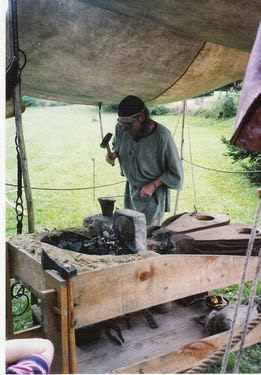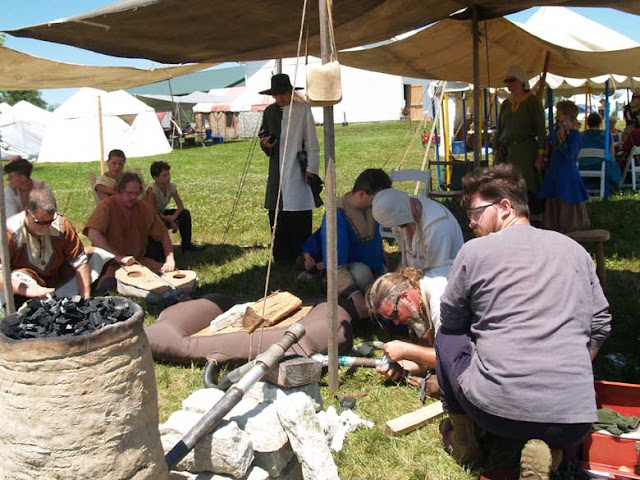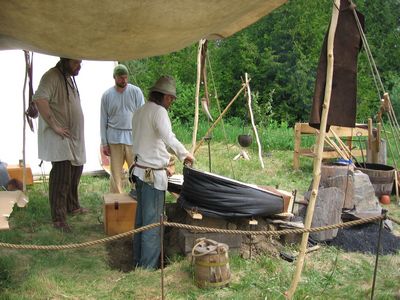This overview prepared as background to an interview I will be undertaking on October 7. This is in support of a research project by Amy-Eva Nuttall at the University of Sheffield (UK). For the Master’s Dissertation : ‘Investigation into Bronze Age bellows in literature and experiment’.
My original development of blacksmithing skills included working at a 'Settlement Era' (1850's) living history museum in Toronto. The forge used a 'Great Bellows' - a type standard for that time and place. Over the years, I have worked with later period (1860's +) hand driven rotary blacksmith's blowers on forges - and have several of that type here at the Wareham Forge.
It should be noted that my own experimental work has been primarily related to ‘Late Iron Age’, cultures (Norse, Pictish, Celtic), and focused on bloomery iron smelting. Some testing of bronze casting method (Norse) using historic equipment has also been undertaken in bits and pieces over the years. Bellows have been used extensively in the glass bead making experimental series.
Norse Twin Chamber - ‘Blacksmith’ (4 smelts)
Based primarily on the (well known) Hyllestad Church Carving
There are a large number of commentaries related to this piece of equipment available on this blog :
https://warehamforgeblog.blogspot.com/2008/01/bellows-reconstruction-2.html
I have made at least a half dozen individual equipments based on my evaluation of the two available Viking Age illustrations.
A series of delivery volume tests were made :
http://www.warehamforge.ca/ironsmelting/bellowstest.html
- This bellows has been used over the years on a Norse ‘sand table’ type blacksmithing forge, firing charcoal. It has proved quite effective for general forge work, and capable of generating welding temperatures.
 |
| Viking Age forge demo - Haffenreffer Museum, RI - 2006 |
- The same type of bellows has been used for a number tests and demonstration of small scale bronze casting, heating roughly fist sized crucibles effectively.
 |
| Upper Canada Village Medieval - 2019 |
- The same type of bellows is used for the series of glass bead making experiments by Neil Peterson . In this case it has proven that care needs to be taken to not produce too much air volume for effective glass working.
 |
| Neil Peterson, Megan Roberts - 2008 |
- At least one set of demonstrations of the 'Aristotle' re-melting furnace used the Norse blacksmith's bellows.
 |
| Trillium War (SCA) - 2008 |
The earliest iron smelts I undertook were attempted with this same bellows. Over four experiments, it was certainly demonstrated that this bellows, which produces on average 120 LpM just did not produce enough air to effectively smelt iron, inside a typical ‘short shaft furnace.
 |
| Early Iron 1 - 2004 |
Norse Twin Chamber - Blacksmith’s linked by bladder. (1 smelt)
This
was a single ‘concept’ experiment, where a series of three smaller
blacksmith’s sized bellows (described above) were linked to a single
large air bladder, then from there into the smelting furnace. Although
the overall system proved reasonably effective, the labour pool required
was extremely large.
 |
| SCA 50 Year - 2015 |
Norse Twin Chamber - ‘Ubber’ Bellows (6 smelts)
In connection with the experimental series related to the archaeologically proven iron smelt in Vinland (at L’Anse aux Meadows NL) a greatly oversized twin chamber style bellows was built. In this case the form of the Norse illustrations was extended, with the intent of creating a piece of equipment that would produce the air volumes indicated for best function in the short shaft furnace.
This bellows, due to its huge size, was found to be far too punishing on the workers, especially over the many hours of constant operation required for a full bloomery smelt.
 |
| with Dave Cox, Keven Jarbeau, CanIRON 5 prep - 2005 |
Norse Twin Chamber - ‘Smelting’ Bellows (5 smelts)
Based on the work above, a mid sized Norse styled bellows was built. This was used for the ‘Vinland’ series, experiments leading up to demonstrations at L’Anse aux Meadows itself. It also has been used for workshops where either historic setting or lack of electricity has required human power.
 |
| Ken Cook, Vinland 3 - 2009 |
‘Celtic’ Drum Bellows (test only)
A short attempt was undertaken to work up a bellows of this type. The results were not the best, primarily a heat failure of the (plastic!) one way valve used.
https://warehamforgeblog.blogspot.com/2017/06/2-celtic-iron-age-bellows.html
’Chinese’ Box Bellows (partial)
This system was quickly dubbed the ‘Franken-Bellows’. A wooden square box bellows was mechanically powered by an electric motor driving a modified bicycle crank set to convert rotary power to back and forth action. This was only used for part of one smelt (Vinland 2, 2009)
 |
| 'Franken-bellows' in use, Vinland 2 - 2009 |
Looking back, I have to date undertaken 85 individual iron smelts. (Plus a good number more as observer or participating as work team for others).
Electrical powered systems dominate - for the obvious problems with any human powered systems of labour required, and effective equipment builds.
- ‘Vacuum Cleaner’ - at least four different types (9 smelts)
- ‘Leaf Blower’ - used in Scotland for the Turf to Tools series (7 smelts)
- The standard electric blower used for all the remaining smelts is a high end ‘compressor’ style blower, (US Navy surplus : rated at 1400 LpM - continuous duty).
It should be mentioned that 'Victorian' hand cranked rotary blowers
have been found to deliver high volumes - but at such low delivery
pressures that effectively air is not forced into smelting furnaces as
required.
Although part of a much larger discussion, repeated duplication of nearly identical smelts (same furnace / furnace build, same ore * ) has clearly demonstrated the 'high volume air' effect first documented by Lee Sauder and Skip Williams (2002). With the change from a high volume, constant air blast, blower, effective yields have been found to drop from the range of 25% down to the 15% range. I consider this significant. It is certainly true that ore can be reduced into metallic iron blooms with the use of less efficient furnace builds, and employing lower are volumes. But the overall yields and importantly the quality in terms of density of blooms created with low volume, human powered bellows does not match the known artifact blooms (from the Viking Age, at least). With high volume air, the blooms we create look most like these artifact samples.
* ) This is most clearly seen in the Vinland series, where effective yields dropped from 28% (electric) to 14% (bellows).





















No comments:
Post a Comment